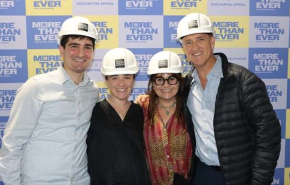Israel denies any role in huge Iran port blast
Israeli officials denied on Saturday any connection to the massive explosion that rocked the Port of Shahid Rajaee, Iran’s largest, on Saturday, killing at least 18 people and injuring more than 700 others.

The Port of Shahid Rajaee, Iran’s largest, on the Strait of Hormuz, Jan. 27, 2020. Credit: Fars Media Corporation via Wikimedia Commons.
A large plume of smoke was seen above the port, one of two located in the city of Bandar Abbas in southern Iran. The Port of Shahid Rajaee is located on the north shore of the Strait of Hormuz, about nine miles west-southwest of the Port of Bandar Abbas.
Initial reports suggested that the blast was linked to a shipment of a chemical ingredient used to make fuel for ballistic missiles.
Iranian authorities did not disclose any information about the cause of the blast, though they denied that it was linked to the country’s oil industry, AP reported.
A spokesperson for the Islamic Republic’s crisis management organisation, Hossein Zafari, told Iran’s ILNA news agency that “the cause of the explosion was the chemicals inside the [shipping] containers.”
In March, private security firm Ambrey said, the Port of Shahid Rajaee had unloaded a shipment of “sodium perchlorate rocket fuel,” according to AP.
“The fire was reportedly the result of improper handling of a shipment of solid fuel intended for use in Iranian ballistic missiles,” the security firm added.
The Financial Times in January reported that the fuel was sent from China to Iran in two vessels, as the Islamic Republic was looking to replenish its depleted missile stocks after firing about 200 ballistic missiles at Israel in October 2024.
AP also reported that one of the vessels has likely carried the chemical ingredient to the port in March, after analysing ship-tracking data.
Iran never confirmed accepting the shipment.
Western explosives and munitions experts say that the orange smoke observed from the blast is consistent with the burning of nitrogen compounds, which are a key component in rocket fuel.
An enormous explosion due to the instability of these chemicals occurred at the Port of Beirut in Lebanon in 2020, killing 218 people, injuring more than 7,000 others and displacing some 300,000 people. Some suggested the blast was created by explosive material reportedly stored at the port by Hezbollah.
The Port of Shahid Rajaee is a strategic import and export facility for Iran. It handles 85% of the total loading and unloading carried out at the country’s ports, the Tehran Times reported in September 2021.
It is also a key port from which arms are transported to the Iranian-backed Houthis in Yemen.
All operations in the port have been reportedly halted.
Cmdr. (res.) Eyal Pinko, a senior researcher at the Begin Sadat Center for Strategic Studies at Bar-Ilan University, who served in the Israeli Navy for 23 years, estimated in early April that Iran has “several hundred missiles” left in its arsenal, after firing some 300 missiles and drones at Israel on April 13, 2024, and another 200 missiles on Oct. 1, 2024, in two of the largest missile strikes in history.
The attacks featured some of Iran’s most advanced projectiles, including the liquid-fueled Emad, a variant of the Ghader missile (itself a variant of the Shahab 3), the Khorramshahr 2 missile (a solid-fuel missile based on the Fateh 110), and likely use of the Fatah 1 Iranian hypersonic missile.
Israel’s Arrow 3 missile defence system intercepted the majority of the threats in both attacks, with the assistance of the United States and regional states, which also downed some of the projectiles.
Israel responded on Oct. 26 with broad waves of strikes in Iran, targeting Iran’s air defense systems and missile solid fuel factories, as well as, according to media reports, a site at Parchin linked to Tehran’s nuclear program.
JNS








